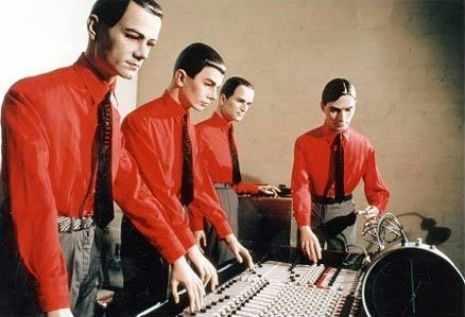It’s like watching an episode of The Twilight Zone.
(via Nerdcore)
It’s like watching an episode of The Twilight Zone.
(via Nerdcore)

If you happen to have a spare 3000 clams laying about you can potentially own the legendary German über-producer Conny Plank’s rack mounted digital delay unit ! There are other, less exciting items from the great man’s studio also for sale, but this particular unit was well used in the early 80’s and probably never more effectively than on this stellar 1981 12” single duet with Holger Czukay under the name Les Vampyrettes. One of my absolute favorite records of all time.
Les Vampyrettes - Biomutanten
Les Vampyrettes - Menetekel

Conny Plank Studio on Ebay
With thanks to Brian Turner via Geeta Dayal !

“I am the operator with my… iPhone?”
I suppose that shouldn’t come as much of a surprise, should it? It’s actually kinda perfect coming from Kraftwerk.
At first glance I thought that this was maybe just some random/semi-random “remix” algorithm tied to a GPS (which it seems to be) but it sounds like once they work out the kinks, that they’ll be adding new functionality.
“It’s a novel system that creates music and sound based on realtime data depending on your location that are continuously feeded into the app, meaning the KLING KLANG MACHINE No1 can’t be compared with other generative music apps which mostly utilize pre-programmed algorithms. There are some nice ways to manipulate sound and store personal preferences. For now the functionality is still kind of basic but the original concept will be more and more implemented in future updates and releases.”
Then again, this is Kraftwerk isn’t it? Hopefully there’ll be updates more frequently than once a decade…

What started out as a joke on Twitter amongst astronomers finally came to be: A Carl Sagan prototype cereal called Astronom O’s!
It’s “Fortified with star stuff.”
Astronom O’s: ‘The Breakfast of People Who Stay Up All Night’
(via TDW Geeks)



360 Cities and photographer Laurent Egli have made it possible to take a virtual tour of the Large Hadron Collider in Geneva, Switzerland. Using a Roundshot D3 camera fitted with a special fisheye lens, Egli was able to capture these magnificent panoramas of the LCH and staff at work. It’s pretty incredible.
360 Cities (Jan): Can you share with our readers how a mortal man can manage to get an invitation to get inside?
Laurent: Taking of these image has been made possible through a meeting with Maximillien Brice. Max is the head photographer for CERN and has become a personal friend of mine. So when he called me to tell me that the LHC was being stopped for some maintenance and that we had a small window of opportunity to go down on monday the 7 th of ferbruary I couldn’t not jump on the occasion.
(via Nerdcore)

New York-based Israeli photographer Noam Galai’s 2006 shots of himself screaming have become unexpectedly widespread emblems of angst and rage that could possibly reach the ubiquity in radical politics of Alberto Korda’s Guerrillero Heroico photo of Che Guevara.
Pro photography blog FStoppers got the exclusive on the fascinating story of Galai’s whim-turned-digital-phenomenon, which spans from his studio to about 40 countries and counting.
After much exploitation of his holler, Galai’s seen fit to cash in himself, which makes sense.

Michael Hansmeyer is an architect and programmer who explores the use of algorithms and computation to generate architectural form, and he has created these incredible cardboard sculptures using algorithms. As he explains on his website:
In recent years, algorithms in architecture have been able to transcend their role as frameworks of formalization and abstraction. This has been made possible in a large part by the integration of scripting languages into CAD programs. Algorithms’ output can now be directly visualized, and through digital fabrication methods this output can be built.
This opens up a new role for algorithms as a design tool. As such, they provide the benefits of depth and breadth. On the one hand, their computational power can address processes with a scale and complexity that precludes a manual approach. On the other hand, algorithms can generate endless permutations of a scheme. A slight tweaking of either the input or the process leads to an instant adaptation of output. When combined with an evaluative function, they can be used to recursively optimize output on both a functional and aesthetic level.
As the New Scientist magazine reports, to make these sculptures:
...Hansmeyer started with a computer model of a simple Greek column and ran it through a subdivision algorithm which repeatedly splits the surface, creating more detail with each iteration.
The result is a 3D model with between 8 and 16 million faces, but 3D printers can only handle half a million, so Hansmeyer needed an alternative solution to transform his creations from virtual to physical reality. He sliced the column into 2700 pieces and used a laser cutter to create each slice from 1mm-thick cardboard, then reconstructed the column by layering the slices together with a solid wooden core. The whole process only cost $1500 and took about 15 hours, with three laser cutters working in parallel.
To see more of Hansmeyer’s work, check here.


With thanks to Iris Lincoln

Inspired by the book, Underground: Tales of Hacking, Madness and Obsession on the Electronic Frontier by Suelette Dreyfus, In the Realm of the Hackers focuses on two Melbourne teenage hackers known as Electron and Phoenix, who in 1989, hacked into some of the most secure computer networks in the world, including the US Naval Research Laboratory, Lawrence Livermore National Laboratory (a government lab charged with the security of the US nuclear stockpile), and NASA.
In the late 1980s, Melbourne was the hub of the computer underground in Australia, if not the world. The hackers who formed the underground were not disgruntled computer professionals or gangs of organised criminals. They were disaffected teenagers who used their basic home computers to explore the embryonic Internet from inside their locked, suburban bedrooms. From this shadowy world emerged two elite hackers known as Electron and Phoenix, who formed part of an alliance called The Realm.
Together, Electron and Phoenix stole a restricted computer security list and used it to break into some of the world’s most classified and supposedly secure computer systems. So fast and widespread was the attack, people assumed it was an automated program, until Phoenix called The New York Times to brag. Soon the US Secret Service and the FBI were on their trail and, within months, the Australian Federal Police had raided their homes.
Using a combination of interviews and dramatic reconstructions, In the Realm of the Hackers charts Electron’s journey from his initial innocent explorations to his ultimate obsession. It vividly recreates the climate of the 1980s, before there was public access to the Internet.
In the Realm of the Hackers takes us headlong into the clandestine, risky but intoxicating world of the computer underground to uncover not only how the hackers did it but why.
In an interview 2003, the film’s writer and director, Kevin Anderson explained the background to his film:
I initially became aware of the story of the Melbourne computer underground after reading Underground: Tales of Hacking, Madness and Obsession on the Electronic Frontier by Melbourne-based author and journalist Suelette Dreyfus.
During my three-year involvement with the project, I had to immerse myself in the computer underground and acquaint myself with terms and concepts I was completely unfamiliar with. Suelette was to become my main conduit to various members of the underground, both past and present.
The story represented a number of “firsts”- the new crime called computer hacking, the first computer crime case to be prosecuted in Australia, the introduction of federal computer crime laws, the establishment of a computer crime unit within the Australian Federal Police, and the first time computer data had been recorded and used as evidence in Australia.
Forming the spine of the story was also the development of the Internet in Australia. Here was an opportunity to show the role that computer hackers played in this and ironically how they were responsible for the creation of the computer security industry, something that wasn’t needed in the early open days of the Internet.
An interesting footnote, Julian Assange helped research Suelette Dreyfus’ book Underground.

Zimoun is a simply wonderful Swiss installation artist that I’ve blogged about previously. Here is some of his quite recent work from shows in San Francisco and Quebec. Somehow the combination of the soft, yet industrial materials amassed in large numbers coupled with the live acoustics leads one to think of any combination of rain, the purring of cats or distant, menacing drummers.
More Zimoun installation clips after the jump…

In 1975, a year before NASA’s Viking 1 spacecraft orbited Mars, Orson Welles presented Who’s Out There?, a NASA produced documentary examining the “likely existence of non-Earthly life in the universe.”
Thirty-six years on, this is a fascinating piece of archive, and rather timely with the news that NASA’s Mars Science Laboratory is due to be launched in November in a bid to make the first precision landing on Mars in August 2012.
Starting with H G Wells novel, and his own infamous radio production of The War of the Worlds, Welles, together with Carl Sagan, George Wald, Richard Berendzen and Philip Morrison, explore what was then “the new view of extraterrestrial life now emerging from the results of probes to the planets,” and conclude that “other intelligent civilizations exist in the universe.”
Carl Sagan: The most optimistic estimates, in the view of many, about the number of civilizations that there might be in the galaxy is of the order of a million, which means that only one in a few hundred thousand stars has such civilizations.
George Wald: That would mean a billion such places just in our own galaxy that might contain life.
Philip Morrison: As I believe there’s a society of these groups, not just one, there’re probably very many. There’s only one, we have no hope of finding them; there’re probably thousands, maybe as many as a million. They probably already have had long history of this same experience, of finding new ones and bringing them into the network.
Carl Sagan: And I would imagine, an advanced civilization wanted to talk to us, they would say “Oh, look, those guys must be extremely backwards, go into some ancient museum and pull out one of those – what are they called – radio telescopes and beam it at them.”
In summation, Welles says:
In 1976 we’re going to be able to explore Mars for perhaps not so humble microorganisms. Before and after that, we’ll be searching the planets and the galaxies for clues to fill in the new patterns we’re discovering, the evolution of evolutions that has produced us and the possible millions of other civilizations….
...The difference between the spacecrafts of NASA and the lurid flying saucery of that old radio War of the Worlds is the difference between science and science fiction and, yes, between war and peace. It’s our own world which has turned out to be the interplanetary visitor; we’re the ones who are moving out there, not with death rays but with cameras, not to conquer but simply to learn. We are in fact behaving ourselves far better out there than we ever have back here at home on our own planet.
Bonus - Orson Welles directs The Mercury Theater’s radio production of The War of the Worlds